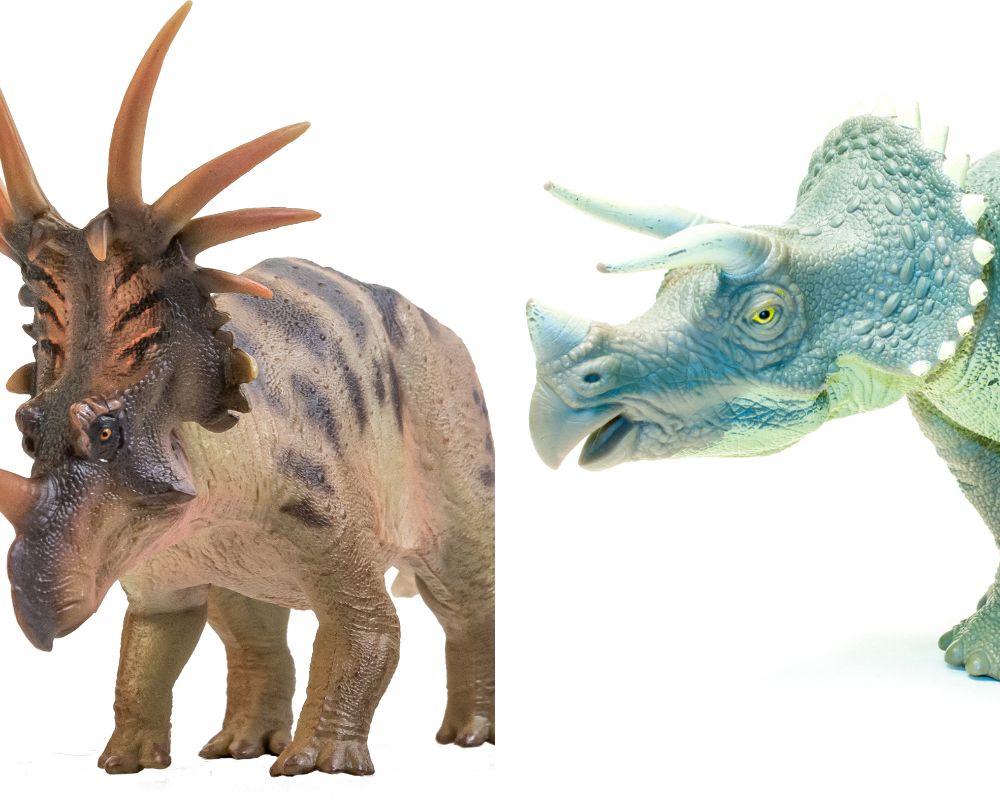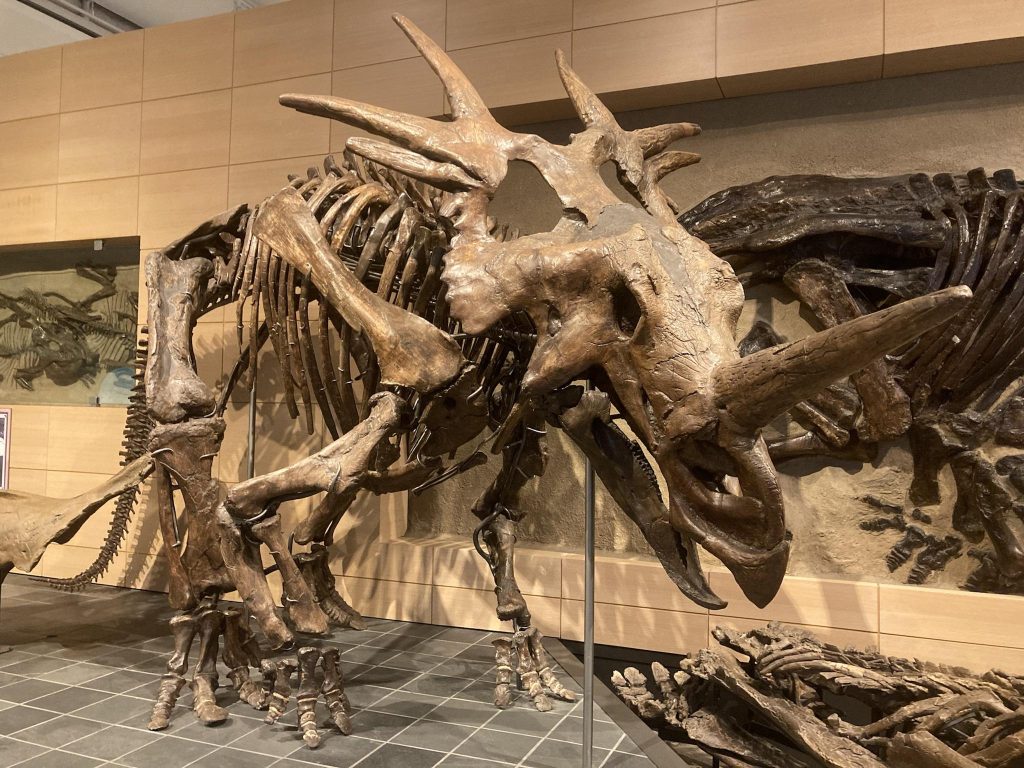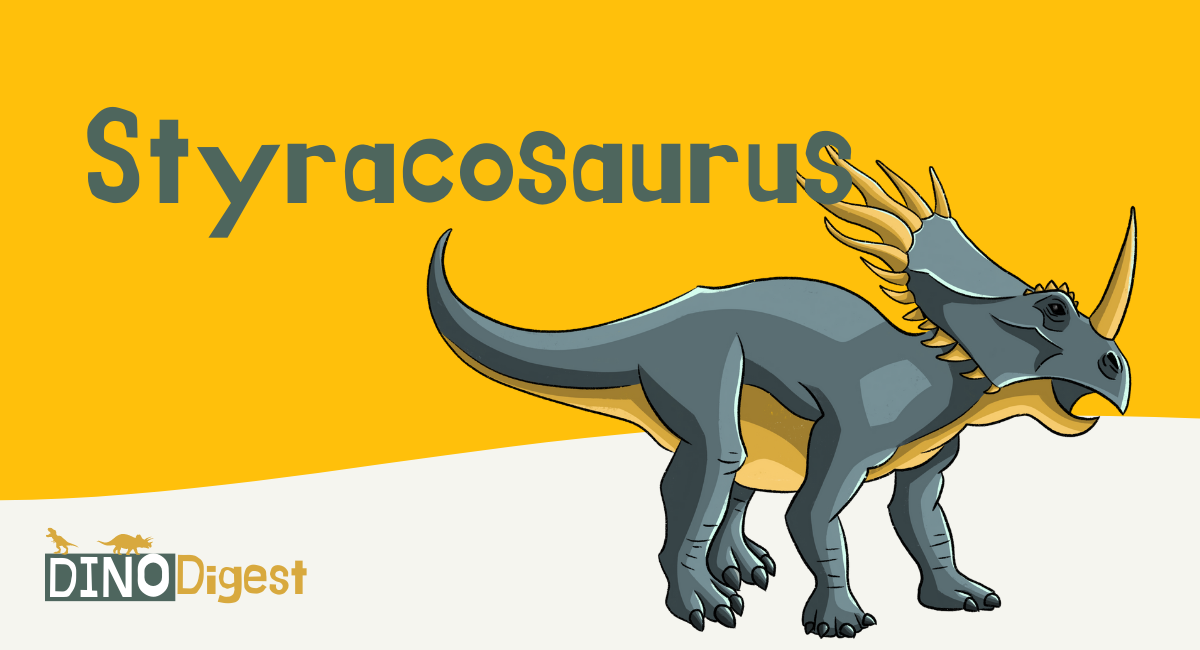The Styracosaurus was a horned dinosaur belonging to the Ceratopsia family of Ornithischia (bird-hipped) dinosaurs. The Ceratopsia family also included the Triceratops, which lived in the same time and area as Styracosaurs. The Styracosaurus was a fierce dino that would’ve been an apex predator if it wasn’t a herbivore.
Table of Contents
Some Quick Facts about the Styracosaurus

| Name | Styracosaurus (meaning “spiked lizard”) |
| Type of dinosaur | Centrosaurine Ceratopsian Dinosaur |
| Territory | Heavily forested floodplains with plenty of rivers, North America |
| Size | Relatively large, 5-6 feet tall, 18 feet long |
| Color | Likely greenish/brown |
| Interesting Characteristics | Big head with a long horn on the nose and a neck frill. Thick body with short legs and a tail. |
| Diet | Herbivore |
| Major Threats | Natural disasters and climate change |
The Styracosaurus was a fierce herbivorous dinosaur (like Camarasaurus) that ate mostly cycads and prehistoric ferns.
Styracosaurus fossils have been found in bone beds in Canada and Montana. Styracosaurus skulls were dome-shaped, plus they had a long nose horn and neck frills.
Are the Styracosaurus and Triceratops Related?

Styracosaurus and Triceratops belonged to the same dinosaur family and are somewhat related. But Styracosaurus belongs to a subfamily of Ceratopsidae called Centrosaurinae. The Triceratops was not part of this suborder. And this group of horned dinosaurs was known for nose horns longer than any brow horns, if they have brow horns at all.
The Centrosaurus, Einiosaurus, and Pachyrhinosaurus, along with other Centrosaurines are more closely related to the Styracosaurus than the Triceratops. The Styracosaurus’ closest relative was the Centrosaurus. The group Centrosaurine gets its name from the Centrosaurus.
Did the Styracosaurus Have Teeth?

Styracosaurus had teeth, but they didn’t look like teeth at all! The Styracosaurus skull had a beak and cheek teeth. These teeth were arranged in a dental battery. This means their teeth were in rows and stacks that would regrow repeatedly over time.
The rows of teeth worked together to crush and grind the tough plants. This made the plants easier to digest. New teeth appeared in the mouth all the time, replacing the ones that were ground down.
Because of how the teeth wore down and were replaced, the Styracosaurus had hundreds of teeth over its lifetime.
What Dinosaurs Did the Styracosaurus Live With?

Paleontologists Lawrence Lambe and CM Sternberg first found Styracosaurus fossils in the Dinosaur Park Formation in 1913. In 1915, veteran fossil hunter Barnum Brown found another Styracosaurus fossil. Eventually, a bonebed was unearthed that contained several different species of dinosaurs.
This formation is located in Alberta’s Dinosaur Provincial Park. In the Dinosaur Park Formation, they also found Centrosaurs, Gorgosaurs, Daspletosaurs, and Parasaurolophuses.
All these dinosaurs lived at the same time, so the Styracosaurus lived among all these species. In the Styracosaurus’ southern range of Montana, they also lived with Triceratops.
What Ate Styracosaurus?
Even though the Tyrannosaurus rex was one of the most common predators of North America around the end of Styracosaurus’s lifetime, the T. rex wasn’t the only predator a Styracosaurus had to worry about.
Tyrannosaurs like the Gorgosaurus and Daspletosaurus were the Styracosaurus’s main predators. This was why Centrosaurs, Parasaurolophuses, and Styracosaurs stayed in large herds.
Styracosaurs were slow movers, but they weren’t completely helpless when faced with a Tyrannosaur. Their nose horn was over two feet long and could impale other dinosaurs. The Styracosaurus skull was also very hard, causing lots of damage when used as a battering ram.
The Styracosaurus might not be as well-known as its relative the Triceratops. But this horned dinosaur was an impressive prehistoric animal. Its long horn and spikes weren’t just for looks.
With its spiked neck frill and massive nose horn, predators definitely had their work cut out for them if they wanted to make a meal of a Styracosaurus.

